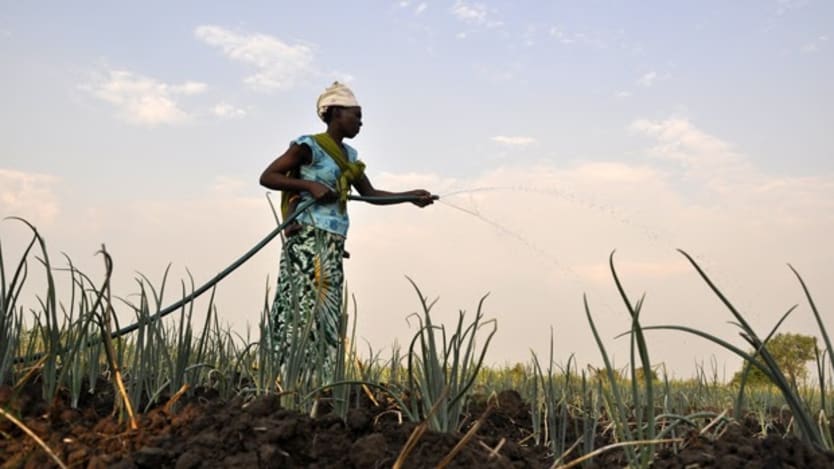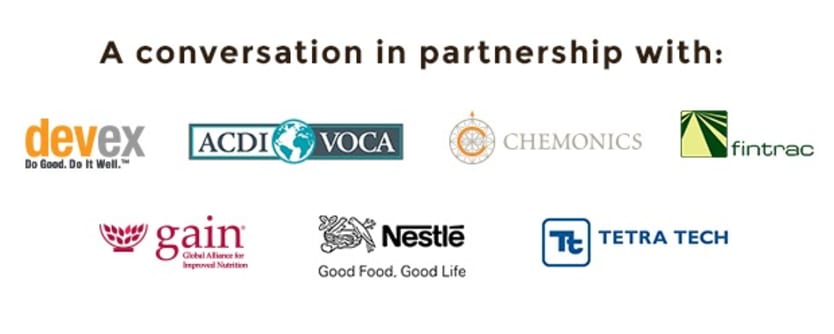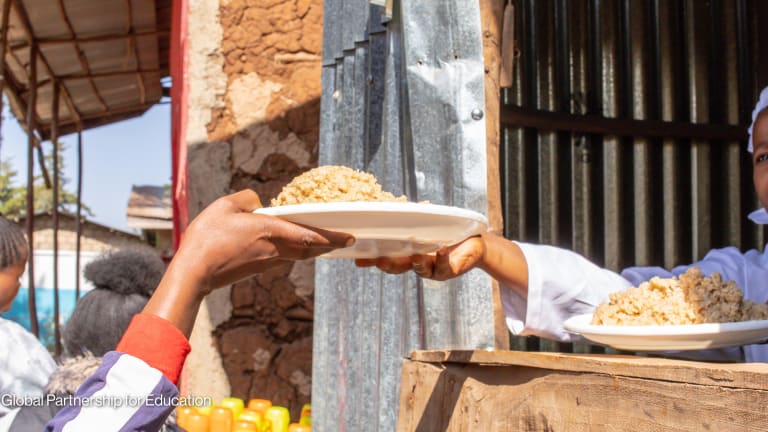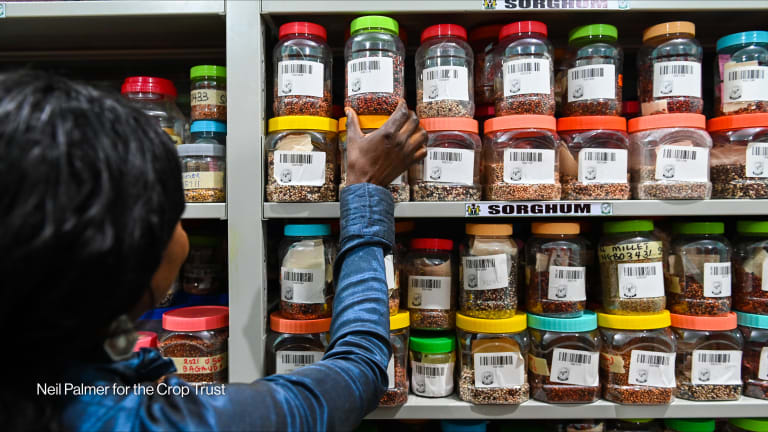
Picture a farmer who tends the land just as his father did, by slashing and burning, clearing the way for the same crops he ate when he was a child to feed his own children. Now imagine an expert in sustainable agriculture entering the community, telling him he should do things differently because, well, it would be better for the environment.
The international community has a major challenge on its hands when it comes to figuring out how to provide 70 percent more food to feed 9 billion people by the year 2050 while still protecting the planet. Rising temperatures are placing new strains on farmers at the same time that a growing population is placing new strains on the land, with climate change leading to food insecurity and environmental damage that will be difficult to reverse.
Solutions at the nexus of food security and the environment are necessary both to feed the hungry and save the earth. Here are some insights to drive the process.
1. Why there’s no silver bullet for resilience.
Natural hazards, from disease to floods to droughts, hit the poor the hardest, as they have the fewest resources to withstand shocks to their system. In the Horn of Africa, for example, the devastating hunger 12 million people across Somalia, Kenya, Ethiopia and Djibouti experienced in 2011 and 2012 was due not only to changing weather patterns but also to the inability of governments to set up systems to deal with food and water shortages. The international community — including governments, corporations, nonprofits and aid workers — has a critical role to play in making communities more resilient to the effects of climate change and other challenges, and to help them maximize food and water security in the face of uncertainty.
Agroforestry, for instance, may help a patient farmer replenish soil, reduce erosion and increase food production over a substantial period of time as trees and shrubs grow alongside crops on their fields. Small-scale horticulture may boost food production without increasing environmental damage; the practice is growing in popularity as peri-urbanization opens up new opportunities to integrate agriculture with the hybrid landscape.
But it has become clear there is no one way to ensure food security resilience.
“In the 1980s and ‘90s, agroforestry was presented as a potential solution to the planet’s problems. It became a kind of panacea,” said Michael Brown, director of environment and natural resources at Chemonics.
Why has the practice not spread? The answer, Brown suggested, lies in a variety of challenges. Many people don’t own the land they farm, for instance; others seem to favor short-term gains to long-term benefits, opting for fast-growing trees they can sell for timber.
There is no one-size-fits-all solution to promote food security while protecting our planet. Instead, a range of techniques and technologies need to be integrated and adopted, with the agriculture and environmental communities setting an example by coming together around sustainable agriculture.
2. The problems presented by the high-income consumer base.
While many of the tensions between feeding the hungry and conserving the environment call to mind images of those in poverty, the higher-income consumer base presents its own challenges, from increasing the demand for more expensive foods to allowing controversy to get in the way of innovation.
A growing appetite for meat among China’s growing middle class, for instance, has contributed to a growing trend of countries seeking out farmland across Africa. Beyond the strain this puts on the soil, a rising demand for meat has resulted in increased methane gas emissions from cow manure and problems with water supply from poor irrigation practices, according to Mario Kerby, deputy chief of party for an environmental services project in Haiti overseen by Chemonics.
See more #FeedingDev articles:
● Global food security: Why it affects us all
● 5 ways to tackle climate change and advance food security
● Feeding the world, saving the planet
Conversations at the nexus of food security and the environment often appear black and white. Either you’re for mass industrialization and monocropping and embrace genetically modified organisms or you’re an advocate for organic produce and local farmers who are one with the earth. But there are grey areas. Because organic farming is less productive than agriculture using chemical fertilizer, for instance, if all farmers went organic, much more land area would be required to feed a growing population, meaning forests may have to be cut down.
We can’t take any tools off the table prematurely, said Daniel White, associate director for agriculture at ACDI/VOCA. Sometimes, he suggested, we must put controversial tactics like genetic engineering into play where useful and necessary.
Even where the science is clear, for example in the ways genetic engineering can allow crops to grow even in the face of changes in climate, the politics are murky. Some groups may resist GMOs, for instance, less because of ideological reasons and more of fear that donors like the European Union will withhold funding.
3. The need for, and problems with, pesticides.
While many would argue that killing or controlling undesired pests is a necessary component of any plan to feed a growing population, these agents can also present major environmental challenges, as seen in the recent controversy surrounding neonicotinoids.
These insecticides, called neonics for short, have wreaked havoc on the very bottom of the food chain, from bees, which are essential for pollination, to earthworms, which are essential for soil fertility.
The European Union decided to ban neonics for two years, in part because of growing evidence implicating the insecticides in Colony Collapse Disorder, but in the United States and elsewhere, the practice continues.
Integrated pest management is the best way forward, according to ACDI/VOCA’s White, because it allows farmers to manage pest damage by doing a cost-benefit analysis and balancing economic and environmental considerations rather than applying chemicals to their crops whether or not they are needed.

4. Innovation is nothing without adoption
Even when ideas work on paper, putting them into practice — and scaling them up — can be tough. How can we expect new approaches like portable aquaponics to be transformational when spreading even basic good agricultural practices among farmers takes time?
One barrier is the dearth of adequate extension services for farmers that clarify the link between climate change, food security and biodiversity. Part of the problem with extension programs can be traced to poor governance or a too-narrow focus on specific — often foreign — interventions; in areas where extension programs are privatized, particular seeds or pesticides are often pushed for profit with only a secondary focus on the design of interventions that best serve people at the local level.
Simply asking people what their needs are doesn’t guarantee that foreign ideas will work for them. The farmer who is asked to stop cutting down trees or start growing new crops also has to work through the costs and benefits of whatever changes are introduced to their way of life.
Agricultural practices need to show a positive return on investment for farmers, from improved seed varieties to crop rotation or new biological controls, said Claire Starkey, president of Fintrac, the private agribusiness consulting group.
“Good agricultural practices conserve environmental resources at the same time that they increase productivity and bring farmers more income,” she said. The message: Only a farmer who brings in more money conserving the environment will abandon slash-and-burn agriculture.
Join the conversation at our LinkedIn group!
While it is widely known that one of the surest ways to conserve the environment is to lift farmers out of poverty, social feasibility often stands in the way. One assumption has been that “payments for ecosystem services,” or offering farmers incentives in exchange for their conserving natural resources, will yield benefits both for the environment and for food security. But, as with so many sustainable agriculture strategies, these policies fail if they don’t put people first.
For example, if a farmer can’t get the same yield by growing inorganically or can’t find a market for organic products, it wouldn’t be fair to expect that farmer to grow organically, no matter the environmental implications.
“You really need to have local champions,” said Patricia Caffrey, Tetra Tech’s chief of party for the African and Latin American Resilience to Climate Change program. “We’re bringing that information to the table,” said Caffrey, who describes her role as that of a knowledge broker. “But the champions can actually take that information and effect change.”
5. How water strains are fostering innovation
Climate change poses a severe threat to the global water supply, with unpredictable weather patterns throwing off growing seasons and increased evaporation leading to more frequent droughts. The trick is to capitalize on those consequences in a way that pushes people to begin looking at new ways of doing things, from building ridges down hillsides to planting sorghum instead of maize to overcoming differences in the pursuit of solutions.
White, for his part, is working with Tanzanian rice and maize farmers who are experiencing devastating changes to rainfall patterns. The role of the development community in areas so dependent on specific crops, he suggested, is to capture whatever water is available, promote the use of drought-tolerant seed varieties and encourage different ways to adjust.
As dry areas become more drought prone, some will have to adapt. Results can be remarkable, as they are in the Middle East, where efforts to address the shortage of fresh clean water is leading to rare displays of regional cooperation between Israel, Gaza and Jordan.
Why collaboration is key
The agricultural and environmental communities cannot provide more food to more people unless they come together.
“So much of the environmental agricultural debate is between the ones and the tens and there is so much interesting and useful and good stuff to come out that is much more thoughtful between the fours and the sixes,” said Walter Falcon, deputy director of the Center on Food Security and the Environment at Stanford University.
Rather than dictating a yes-or-no, thumbs-up-or-thumbs-down approach, the international community should help farmers become more aware of, and empowered by, options.
Action from the public and private sector is needed, including from major food and drink manufacturers and distributors. Nestlé, for example, has committed to use only sustainable palm oil in its products by 2015, setting an example as high demand for palm oil leads to deforestation and the endangerment of entire ecosystems.
By helping those who grow our food attain the knowledge, tools and incentives to do so sustainably, we’ll stand a better chance at both feeding and protecting our planet.
Want to learn more? Check out Feeding Development's campaign site and tweet us using #FeedingDev.
Feeding Development is an online conversation hosted by Devex in partnership with ACDI/VOCA, Chemonics, Fintrac, GAIN, Nestlé and Tetra Tech to reimagine solutions for a food-secure future from seed and soil to a healthy meal.








